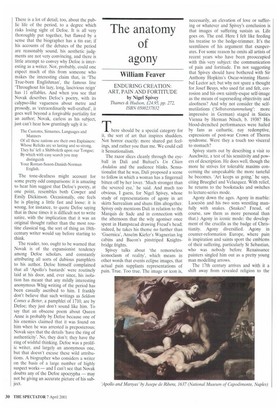The anatomy of agony
William Feaver
ENDURING CREATION: ART, PAIN AND FORTITUDE by Nigel Spivey Thames & Hudson, £24.95, pp. 272, ISBN 0500237832 There should be a special category for it, the sort of art that inspires shudders. Not horror exactly: more shared gut feelings, and rather you than me. We could call it Sensationalism.
The razor slices cleanly through the eyeball in Dali and Bufluel's Un Chien Andalou and the audience blinks. Sensationalist that he was, Dali proposed a scene to follow in which a woman has a fingernail bitten off by her lover. 'Much stronger than the severed eye,' he said. And much too obvious, I guess, for Nigel Spivey, whose study of representations of agony in art skirts Surrealism and shuns film altogether. Spivey only mentions Dali in relation to the Marquis de Sade and in connection with the afternoon that the wily agoniser once spent in Hampstead drawing Freud's head; indeed, he takes his theme no further than `Guernica', Anselm Kiefer's Wagnerian log cabins and Bacon's pinstriped Knightsbridge frights.
Spivey talks about 'the remorseless iconoclasm of reality', which means in other words that events eclipse images, that actual pain supplants representations of pain. True. Too true. The image or icon is,
necessarily, an elevation of love or suffering or whatever and Spivey's conclusion is that images of suffering sustain us. Life goes on. The end. Here I felt like feeding his treatise to the hedge-trimmer. It's the seemliness of his argument that exasperates. For some reason he omits all artists of recent years who have been preoccupied with this very subject: the communication of pain and fortitude. I'm not suggesting that Spivey should have bothered with Sir Anthony Hopkins's Oscar-winning Hannibal Lector act; but why not spare a thought for Josef Beuys, who used fat and felt, corrosion and his own saintly-esque self-image as the means of superseding objectivity and aloofness? And why not consider the selfmutilations (Selbstverstummelung': more impressive in German) staged in Sixties Vienna by Herman Nitsch, b. 1938? His blood-drenched performances were hailed by fans as cathartic, nay redemptive, expressions of post-war Crown of Thorns syndrome. Were they a touch too visceral to stomach?
Spivey starts out by describing a visit to Auschwitz, a test of his sensitivity and powers of description. He does well, though the more he strives for tolerable maxims concerning the unspeakable the more tasteful he becomes. 'Art keeps us going,' he says, citing Brueghel and Velazquez. With relief, he returns to the bookstacks and switches to lecture-series mode.
Agony down the ages. Agony in marble: Laocoon and his two sons wrestling manfully with snakes. (Snakes? Freud, of course, saw them as more personal than that.) Agony in iconic mode: the development of the crucifix as the badge of Christianity. Agony diversified. Agony in counter-reformation Europe, where pain is inspiration and saints sport the emblems of their suffering, particularly St Sebastian, who was nobody before Renaissance painters singled him out as a pretty young man modelling arrows.
The 17th century arrives and with it a shift away from revealed religion to the
revealed self. Spivey wonders, why the Rembrandt self-portraits? 'In Rembrandt's time, prestige attached to sadness.' Images of troubled ageing appealed, he argues, to a certain clientele. Charles I bought one. So what we take to be utter sincerity could have been no more than a sophisticated pose. Which brings us to Van Gogh. An exdealer himself with a dealer brother, he must have had an eye on the art market. So the furrowed paint was market-led? How donnish can you be? Van Gogh the preacher, yes. Van Gogh the misery guts, if you must. But not, I think, Van Gogh the painconfectioner.
Spivey brings together a wide variety of preoccupations. orders them and intermittently illuminates them. He has a vivid way with sensibilities. Take Buddhist monks. 'Cross-legged, doused in petrol, they changed their flame-orange robes for crackling shirts of fire.' Worrying away at the formulae of expressed emotion, the gestures of referred feeling, he acknowledges that human beings wrestle not with snakes, as such, but with uncontrollable urges. Picasso was brilliant at it. 'And so we make a mess of ourselves.'



























































 Previous page
Previous page